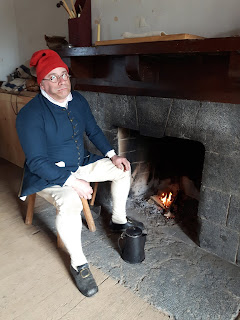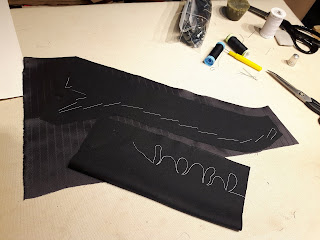No, I realize there's a lack of funding to hire museum professionals across the board, worldwide.
This post will be about assumptions, it will look at an example in Nova Scotia, but also at bigger sites in other parts of the world, sites that should be doing things better, simply because they have larger operating budgets. But no, they still have outdated exhibits like the rest of us, assumptions were made, people in positions thought the visiting public wouldn't notice, or wouldn't know better.
I'll start with the site closest to home, one where I was asked to do outreach programming, a museum in my home community. This site spent a goodly sum of money on a 'make work' project to employ folks in my hometown. They built a replica of the ship Hector that brought one of the first waves of Scottish settlers to my community. Did I mention, they spent a lot of money on this project? Only they missed the mark and neglected to hire a ship builder to oversee the whole project. They hired carpenters who normally build houses. So the replica Hector has no Wheel, no Steering Mechanism of any kind. The hull was also filled with concrete as ballast. The ship looks great from the jetty, from the pub next door, but don't look too closely. She's also rotting due to the concrete being poured wet, and so trapping moisture in the hull, effectively rotting her out from outside and within.
Any sailor of any kind, even a passenger like me notices the lack of steering. Every movie of any tall ship of any kind has featured one scene with someone at the wheel...
 |
| J Graves, artist |
But this isn't the only instance of a replica shipbuilding project not thought all the way through.
The second conversation centred around a gown at the Met. There were serious conversations about how beautiful the textile is that the gown is made of, but then the subject shifted to the mounting itself. What is going on with the front of the gown? Obvious to some of us, the mannikin is too small for the gown, and the wrong shape. Instead of padding it out properly, the fronts are just overlapped. This means that the fashionable silhouette of the gown is lost. The prow shape of the last decades of the 18th century is missing in favour of more of a third quarter 18th century shape that was more upright, more suited to the stomacher front gowns of 1775. The fabric of the gown is also more in line with the really late 18th century, not the 1770s that the shape is trying to be. The Met has missed out on telling the story of the shifting fashions in the decades that finish out the 18th century proper. This mannikin alone causes the viewer to be misled. To my eye, it looks like the mannikin is playing dress-up, akin to wearing a 'hippy' costume at Halloween, instead of what hippies actually looked like in the late 1960s. This causes museum interpreters and living history people to also get finer aspects of dress incorrect. They look to sites such as the Met as an authority. If only there was money to remount these artifacts properly, on properly supported mounts and retake the images to replace the ones found online. Eventually this image might get replaced, but I'm not holding out hope that it will be any time soon.
The third conversation is happening right this minute. A friend is in the UK and took a photo and tagged a bunch of us on social media. The site is Fort George in Scotland, the setting is a barrack room in 1760. I would put the exhibit staging to the mid 1980s. The first thing I noticed wrong was the way the female figure was dressed. A single petticoat, shift, and a knitted shawl. The look is very "mid 1980s rev war reenactor", in fact, several of the ladies in my very first living history unit dressed this way up until the early 1990s when I started handing out bedgowns as fast as I could get them made. Unfortunately, many women still dress this poorly in living history groups...I suspect because of sites like this being seen as an authority. It's heartbreaking because we know better.
Other things are wrong with the scene at Fort George. There's not a properly made bed in the entire room, despite being set up as a lived-in barrack room. The beds were the second thing I noticed, with their pool-noodle sized bolsters which would do nothing to support the head. No blankets, no sheets, no pillows. There are people in the room, but no real living material culture. It's almost as if they just stepped inside this empty room to make lunch and clean a musket. What material culture that is there, is really wrong, like the very modern broom and mop propped up against the back window, circa 1930. This space could be fixed easily and cheaply. Make it an empty barrack room, one vacated by troops. Remove the mannikins, yes, all of them, even the military guys. Remove the household material culture, especially the 20th century broom and mop. Replace the pool noodles with properly sized bolsters (seriously, a preparator could do this project in a day or so) and set the beds up military style for the next company of men who will come in and inhabit the space. Bedding folded like little soldiers on the beds, ready for inspection. Because it would be inspected...militaries have routines that date back to the Roman era.
The thing is, with the dawn of the internet, the public IS becoming far more educated on historical details. If they don't know what is going on in a space or with an exhibit, they are talking about it on social media. We need to do better. We need to be hiring folks who have a clue and can update these exhibits. A well paid site director is only as good as their exhibits. We need to be critical of high salaries of site directors when the budget for exhibit planning and maintenance takes a hit.
Let's demand these sites that we view as authorities step up their game. We need them to be better than Hollywood, and right now, they are lagging behind.
 |
| King's Own Royal Regiment Museum photo |






